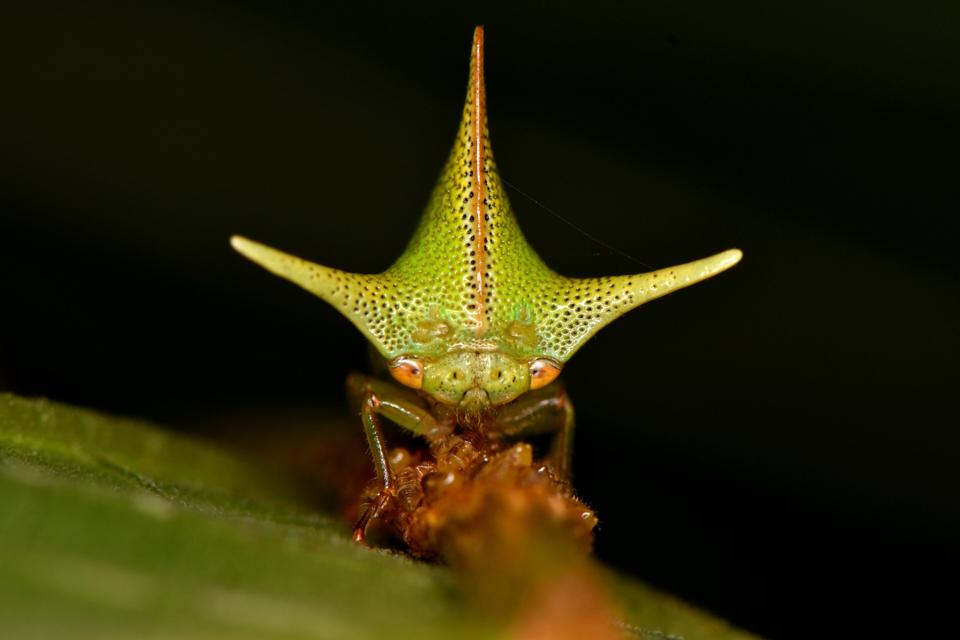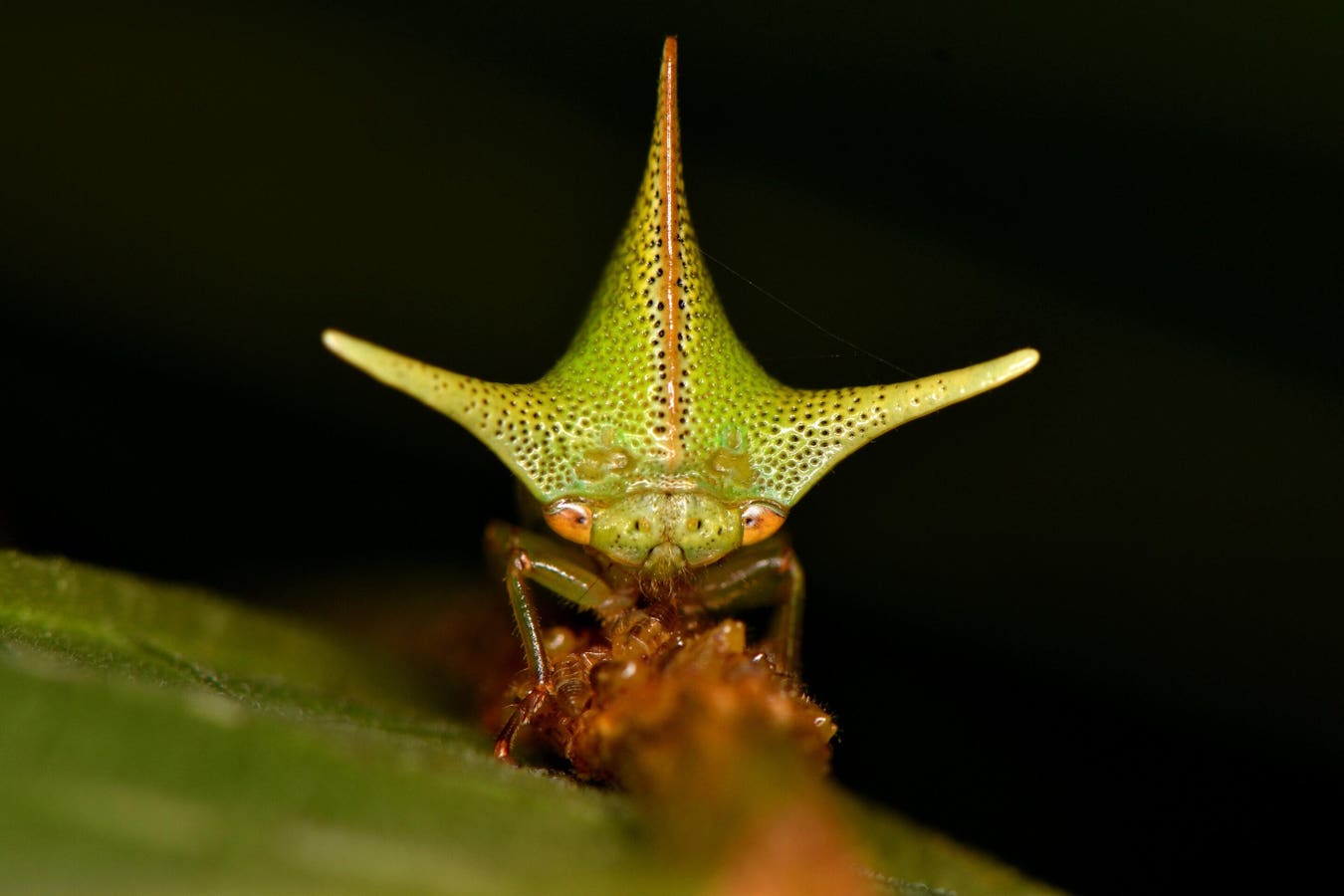Treehoppers detect electrical fields emitted by their predators and may also distinguish between electrical fields emitted by their predators and friendly insects.

Alchisme grossa (Hemiptera: Membracidae) is a species of treehopper found in neotropical Central and South America. These insects are known for their subsocial behavior, with females exhibiting maternal care for their young. (Copyright: Sam J. England, with permission)
Sam J. England
Treehoppers are small, gentle insects that are famous for their astonishing morphological diversity – there’s about 3,200 species of treehoppers in over 400 genera and they vary tremendously in shape and include bizarre features such as horns, spines, balls and tridents (Figure 1).
But what is the function of their extraordinary body shapes? Could it be for camouflage, mimicry, or perhaps for physical defense? These are interesting ideas, but such explanations don’t make sense for the entire family of treehoppers.
F I G U R E 1 : Macrophotographs of wild treehoppers exemplifying a small portion of the morphological diversity seen in the Membracidae, photographed at various locations around Costa Rica (A–J and L) and the United Kingdom (K). (A) Polyglypta costata. (B) Poppea capricornis. (C) Antianthe expansa. (D) Cladonota apicalis. (E) Bocydium mae. (F) Enchophyllum sp. (G) Heteronotus trinodosus. (H) Alchisme grossa. (I) Notocera sp. (J) Ennya chrysura. (K) Centrotus cornutus. (L) Membracis mexicana.
doi:10.1073/pnas.2505253122
Based on the recent discovery that bumblebees and their flowers communicate using static electricity (ref), the authors of that study followed up by asking whether the distinctive body shapes of treehoppers might help them detect static electricity, too.
“If we can link treehopper shapes to certain aspects of their electrical ecology, like specific predators which approach from certain angles with particular static charges, this would really begin to strongly support our ideas around static electricity as an evolutionary driver,” lead author, ecological physicist Sam England, said. Dr England is currently a postdoctoral fellow at the Museum für Naturkunde–Leibniz Institute for Evolution and Biodiversity Science, but this particular study was part of the requirements for the PhD at the University of Bristol.
Dr England and collaborators investigated this phenomenon by using a picoammeter to measure treehopper static electricity (Figure 2A). They found that these insects retreat from electrical fields.
F I G U R E 2 : The net electrostatic charges measured on treehoppers (N = 151), predatory wasps (N = 22), and mutualist bees (N = 301). For raincloud plots, points indicate individual measurements; box and whisker show median, lower, and upper quartiles, and range; half-violin shows distribution of each dataset. Vertical dashed lines signify transition from negative to positive charge polarity. Asterisks denote statistically significant differences (*P < 0.05, ***P < 0.001). Please note different axes scales between plots. (A) Net charges of treehoppers. Clades include P. capricornis (N = 18), P. costata (N = 9), Notocera sp. (N = 3), M. mexicana (N = 13), H. trinodosus (N = 6), Enchophyllum sp. (N = 3), C. apicalis (N = 1), Bolbonota sp. (N = 1), A. expansa (N = 55), A. grossa (N = 32), and Aconophorini (N = 10). (B–E) Charge characteristics of predatory wasp species (red) including Mischocyttarus basimacula (N = 14) and Mischocyttarus cf. angulatus (N = 8), and mutualist bee species (green), including Scaptotrigona subobscuripennis (N = 144) and Tetragonisca angustula (N = 157). (B) The net electrostatic charge for individuals of each species. (C) The net electrostatic charge of individuals grouped by relationship to treehoppers. (D) The proportion of positive (red) versus negative (black) net electrostatic charge polarities for individuals grouped by relationship to treehoppers. (E) The net electrostatic charge magnitude of individuals grouped by relationship to treehoppers.
doi:10.1073/pnas.2505253122
Dr England and collaborators then found that predatory wasps emit electrical fields (Figure 2B,C,D,E) that are significantly different in both magnitude and polarity from those emitted by friendly stingless bees that often protect treehoppers from their predators.
This difference in electrical charge suggests that treehoppers may use electroreception to distinguish between friends and foes, and thus provides a powerful evolutionary reason for treehoppers to have sensitive electroreception capabilities.
Dr England and collaborators then used computational methods to demonstrate that the extreme body shapes of treehoppers enhance the electric field strength around the treehopper, and this likely increases their sensitivity to static electricity, thereby providing a powerful reason for them to evolve and maintain their weird body shapes.
A Bocydium treehopper. (Copyright: Sam J. England, with permission)
Copyright: Sam J. England
Are all insects capable of electroreception?
“We don’t know for certain how widespread this electrostatic sense is, but given the diversity of animals already shown to have it, plus the breadth of ecological functions they use it for, we feel quite strongly that this sense may be very widespread, especially amongst insects and other small animals,” Dr England replied in email.
If electroreception is so widespread amongst insects, why aren’t they all bizarrely shaped?
“The answer is likely manyfold, but one answer is that evolution is a process dictated by chance and tradeoffs,” Dr England explained in email.
For example, although many animals would probably benefit from having the acute vision of an eagle, most lineages haven’t evolved the sensory adaptations necessary for such good vision because the random mutations required to start building a highly acute eye haven’t occurred in their lineages, or the physiological cost of maintaining such an eye in most species is greater than the survival benefit they would gain from having better vision, making it maladaptive to have such acute vision.
“In the same ways, maybe treehoppers just happened to stumble across the original mutations that allowed them to grow these elaborate pronotums that other insects just didn’t get so lucky with,” Dr England observed in email, “or something about the electric ecology of treehoppers, like the subtle differences we observed between the charges of predators and mutalists of the treehoppers, means they especially benefit from a hyper-sensitive electroreceptive system, that justifies the costly construction of these large electroreceptive structures.”
By demonstrating that the extreme morphology of treehoppers increases the strength of electric field stimuli around these animals, Dr England and collaborators suggest that the enigmatic function of their spectacular pronota is partly as an electroreceptor, and that natural selection for increased electrical sensitivity may have contributed to their diverse evolution.
“We think our study provides a really exciting launch pad for investigating static electricity as a driver of organismal morphology more generally,” Dr England said.
Dr England and collaborators are planning to investigate how different treehopper morphologies could be adaptive for different electrical environments. Further, there’s other insects, spiders, animals – and even plants – that also have really extreme shapes, which in many cases are currently without explanation.
“Our study provides the first evidence of the electrostatic sense potentially driving morphological evolution, but we can’t prove this just yet.”
Source:
Sam J. England, Ryan A. Palmer, Liam J. O’Reilly, Isaac V. Chenchiah, and Daniel Robert (2025). Electroreception in treehoppers: How extreme morphologies can increase electrical sensitivity, Proceedings of the National Academy of Sciences 122(30):e2505253122 | doi:10.1073/pnas.2505253122
© Copyright by GrrlScientist | hosted by Forbes | LinkTr.ee
Socials: Bluesky | CounterSocial | LinkedIn | Mastodon Science | Spoutible | SubStack | Threads | Tumblr | Twitter

